Referral Routing
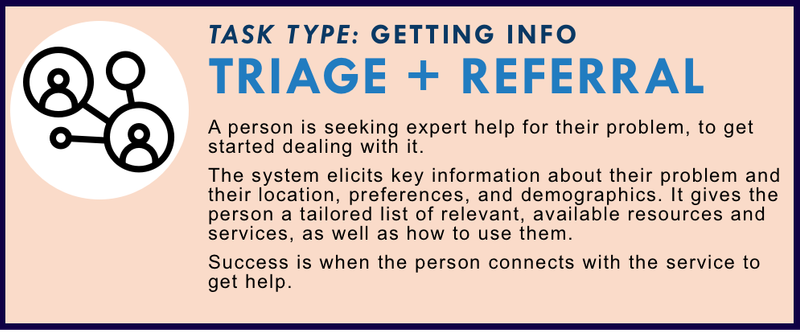
Match people with appropriate legal help providers (including service organizations, tools, and information sources) by taking in their situation, triaging their situation, and matching them with a service listing.
Task Description
When someone is facing a legal problem, their first step is often to search online or talk to a front-line navigator, court help center staffer, or intake worker. But the legal ecosystem is complex. People struggle to know whether their issue is legal, which organization to turn to, or what steps to take. Without good triage, they can get lost, discouraged, or referred to the wrong place.
This task focuses on a system that serves as a smart triage assistant and resource router. The person briefly describes their situation. The system follows up with conversational or form-based questions about the person’s issue, location, demographics, preferences (e.g., language, disability access), and urgency. It then matches them with the right help options: legal guides, forms, FAQs, or service providers they’re eligible for.
The system isn’t just a search engine—it is guided, adaptive, and focused on conversion. It routes users to trusted legal aid groups, court-based services, or self-help tools with a clear explanation of why the resource is relevant and what to do next. It supports real-time customization based on changing services, intake rules, and jurisdictional logic.
This tool is valuable for public-facing legal help websites, community navigators, intake portals, and court kiosks. It can also assist junior staff or volunteers in giving more accurate referrals and guidance. Its main goal: reduce drop-off, prevent misreferrals, and empower people to connect to services that can actually help.
Success means that users are matched with the right resource or provider and take meaningful next steps toward resolving their issue—without getting stuck or misdirected.
Primary audiences
People seeking legal help online;
intake teams;
navigators and community justice workers;
court help center staff;
legal help website administrators
Existing Projects
Several robust foundations for this idea already exist:
- Michigan’s Guide to Legal Help: A curated triage + resource matcher.
- North Carolina’s Legal Help Directory
- Chatbot-based guided triage attempts (e.g. in Texas, Illinois)
- Several TIG-funded triage tools, though some are outdated or fragile
- LegalServer and Salesforce integrations for resource matching
“That’s what we try to get our bot to do! We gather details, ask about location and type of problem, then offer tailored matches.”
“Our Guide to Legal Help has a wealth of information, but we’re limited in scale. An AI assistant could make it feel more natural, less like a form.”
Technical Next Steps & Protocols Needed
- Eligibility logic trees standardized across organizations
- Service directory integration with up-to-date intake status and eligibility rules
- Centralized protocol to format intake questions, location rules, and redirect logic
- Ability to record and analyze user journeys post-referral
“Standardizing the format for intake criteria (income, region, status) would help everyone.”
Stakeholder Commentary
Respondents expressed strong enthusiasm and clear warnings:
- AI adds huge value when resource logic is too complex to show in a list or static guide.
- The “last mile” handoff matters most—where, how, and when a user contacts a service.
- Eligibility complexity is a huge challenge, especially for public benefits, immigration, and nonprofit legal aid with strict rules.
“The problem is not the technology but the data. Many orgs don’t expose eligibility or intake conditions in a usable way.”
“A good matcher doesn’t just say 'go here.' It says: Here’s what to expect, how to prepare, how long it’ll take.”
- Could we build a national intake/triage schema for legal help organizations
- Allow AI to act as a “triage copilot” for live navigators, not just public-facing
“It would be helpful to have an AI bot that can pre-screen for income and immigration status, but still refer to live intake if unsure.”
- Matching is hard without clean service data: Hours, availability, eligibility, languages are often messy or outdated.
- Some felt the problem is less technical and more relational — orgs must agree to expose intake logic and keep data up to date.
- A few noted that referral is a complex social act, not just a technical one.
“The problem with this is not the technology but the people and politics of service networks.”
“A threshold challenge with any logic-based referral system is the sheer variability of who’s eligible.”
How to Measure Quality?
🧠 Issue Spotting and User Context Gathering
- Accurately identifies the user’s legal issue from free text or dropdown options
- Asks for and correctly interprets key data: location, urgency, eligibility factors, preferences
- Avoids overwhelming or irrelevant questions
🗂️ Resource Matching Accuracy
- Matches user to correct services and resources based on geography, issue type, and eligibility
- Includes multiple types of resources: legal aid groups, clinics, guides, forms, chat tools, etc.
- Differentiates between high-risk vs. self-help-appropriate situations
📋 Next Step Clarity
- Explains how to use the resource or contact the provider (e.g., intake hours, form steps, documentation needed)
- Flags any follow-up required (e.g., deadlines, calls to confirm eligibility)
- Provides immediate options if primary match is unavailable
💬 User Experience and Accessibility
- Presents matches in plain, clear language with optional translation
- Accessible across literacy levels, languages, and devices
- Provides supportive tone and reassurance, especially for sensitive or high-stress situations
🔁 System Adaptability and Maintenance
- Pulls from up-to-date resource directories or integrates with referral APIs
- Allows administrators to update services, eligibility rules, or triage logic easily
- Tracks usage trends and drop-off points for ongoing improvement
📈 Success and Conversion Tracking
- Measures whether users contact the suggested provider or complete a next step
- Allows follow-up surveying or usage analysis
- Tracks effectiveness of different triage paths and improves recommendations over time
Stakeholder suggestions for assessing this type of tool:
- Track how many users actually apply or contact matched services
- Accuracy of referrals (do they meet eligibility?)
- Build triage testing frameworks with standard scenarios (e.g., eviction + no lease + kids)
- Follow-up surveys or audits
- User-centered testing on friction and dropout points
“It’s doing a good job if people are not referred to resources that turn them away.”
“It should give tailored answers. If someone says they’ve already talked to a lawyer, it shouldn’t send them to intake again.”
“We need to track whether people actually connect with the resource—not just whether it was suggested.”
Related Projects
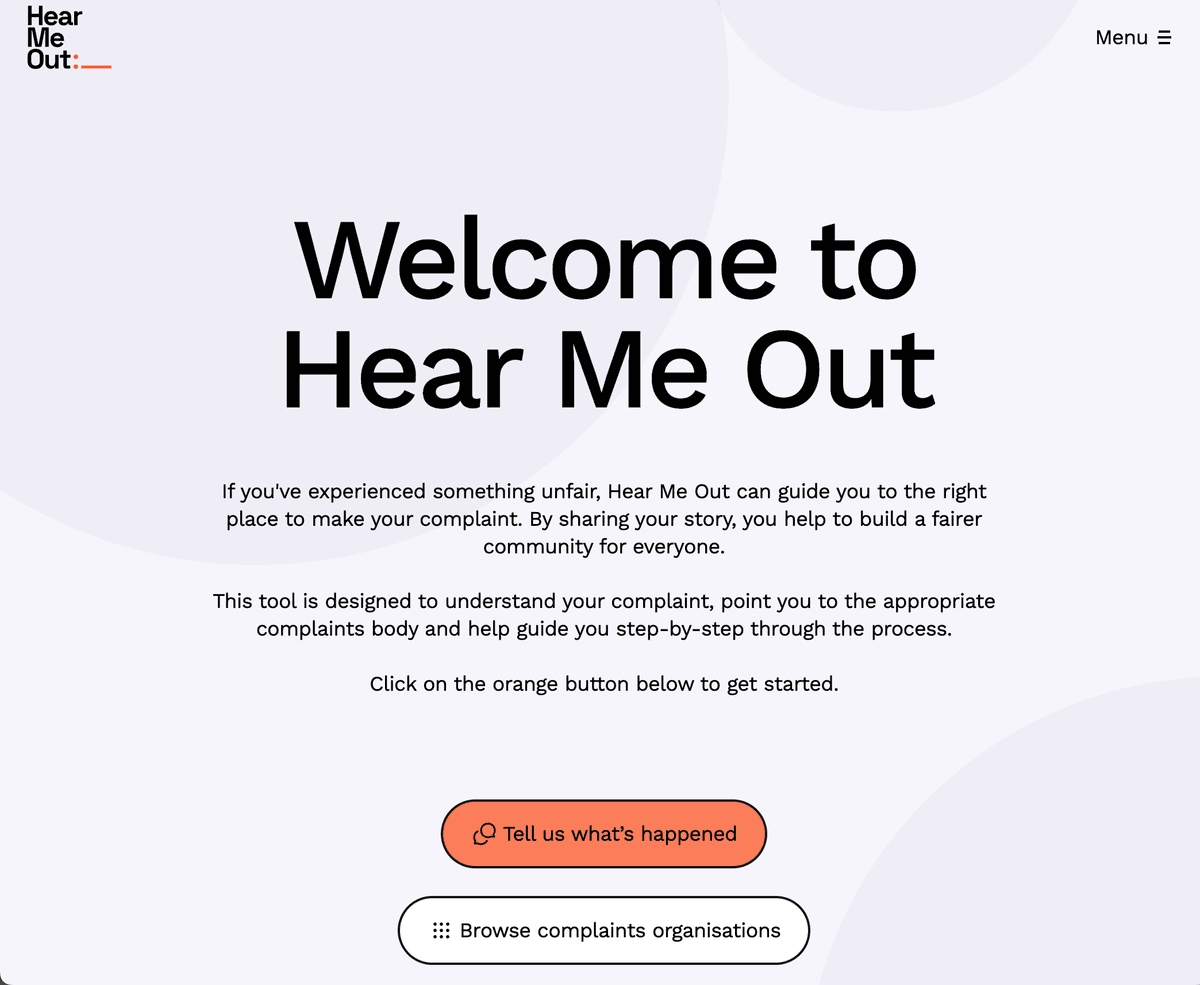
Hear Me Out
A free, AI-assisted platform that helps people in Australia describe their experience and get tailored guidance on where and how to lodge complaints, starting with NSW and Federal bodies and expanding to Victoria.
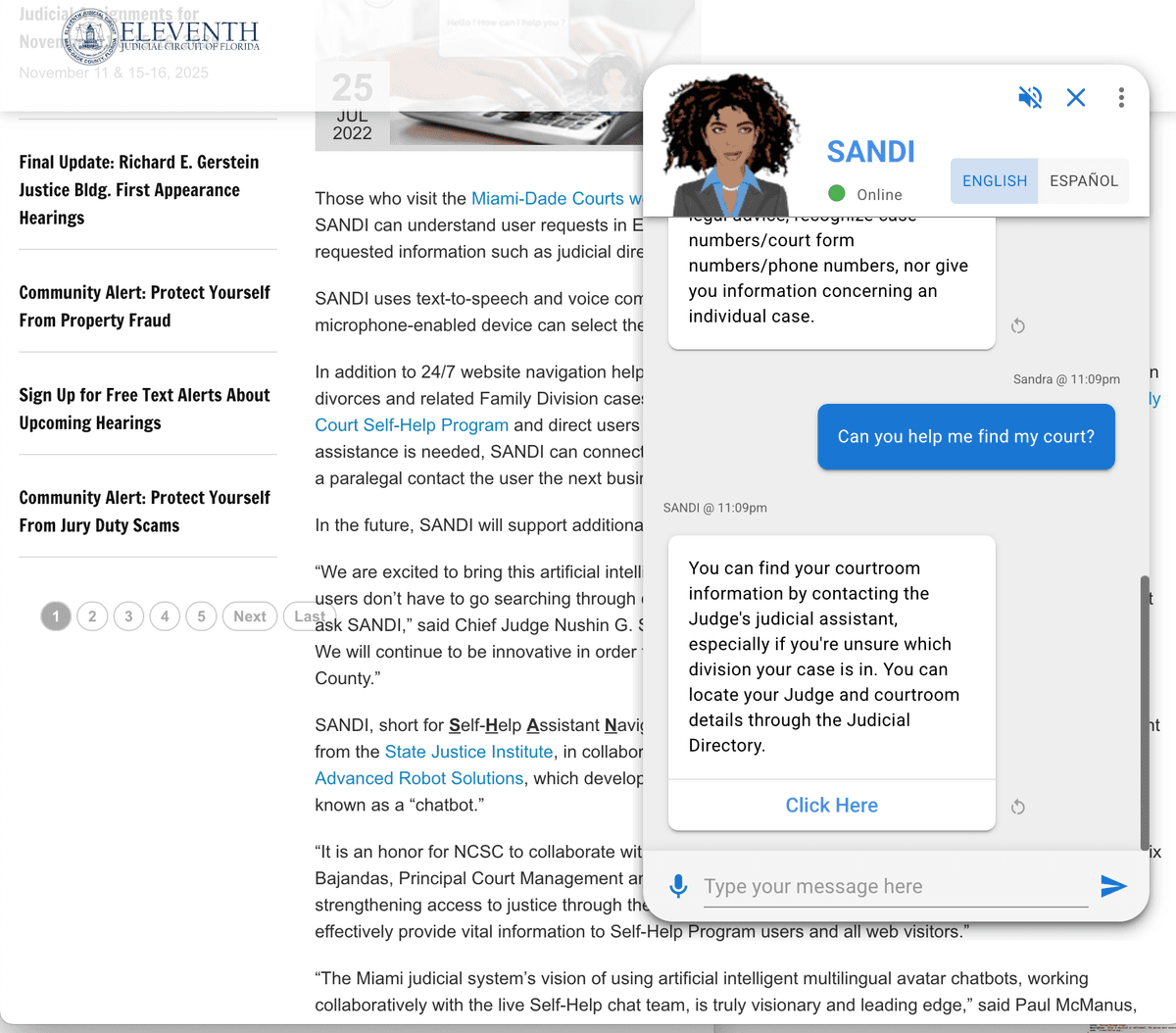
Sandi
A bilingual (English/Spanish) digital assistant on the Miami-Dade Courts website that guides visitors to court information and Family Division self-help resources, with optional voice input and live paralegal handoff.
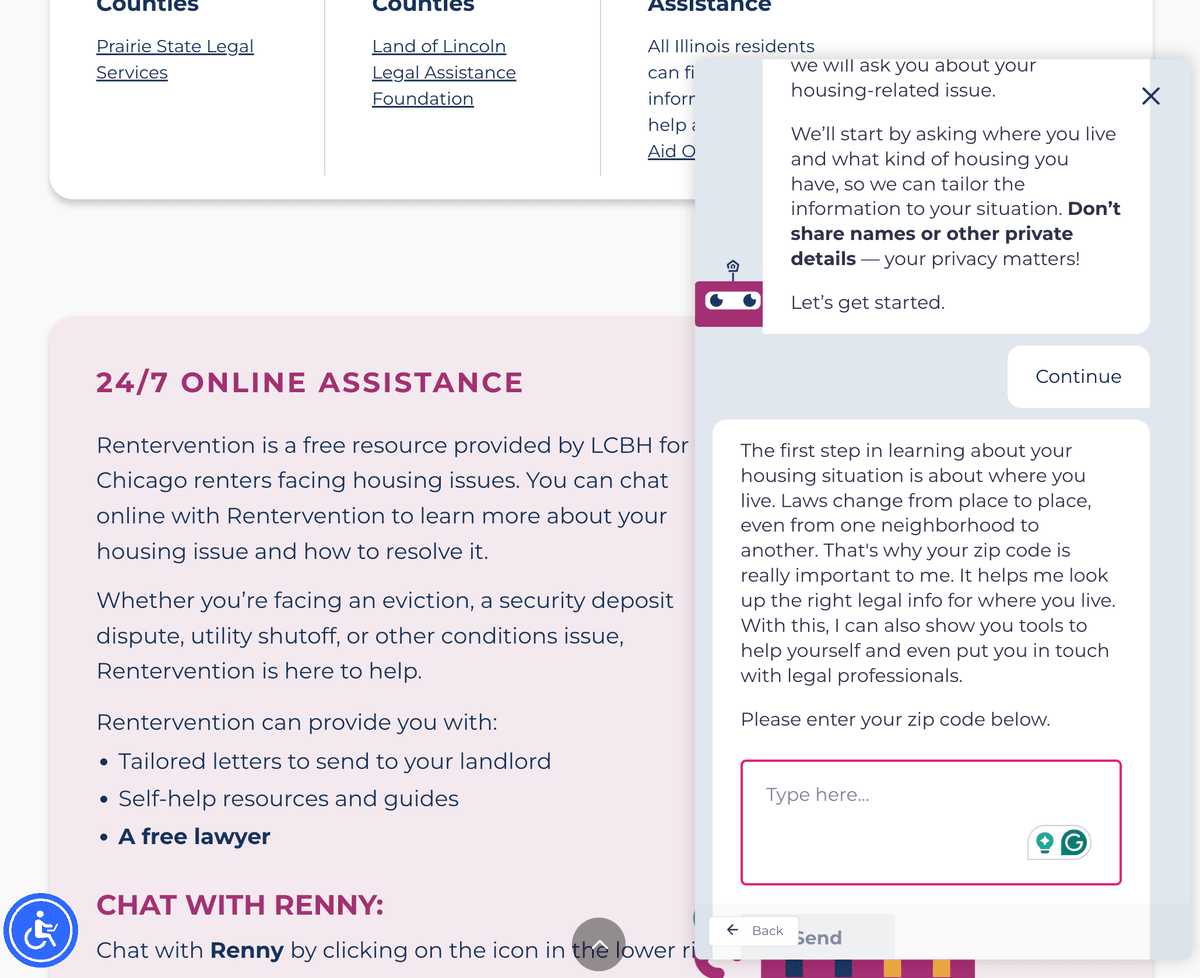
Rentervention
A free, confidential help pathway for Chicago renters that uses an online assistant (“Renny”) to explain rights, draft landlord letters, connect to brief legal advice, and route tenants to appropriate community resources.
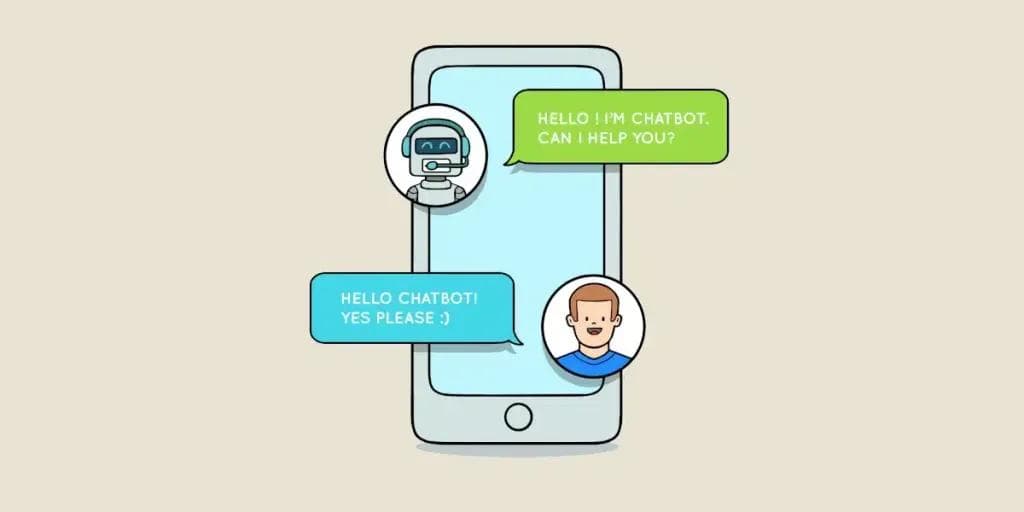
Navi community support chatbot
An AI-powered chatbot that helps community members identify legal issues, find appropriate referrals, and access self-help resources in plain language.
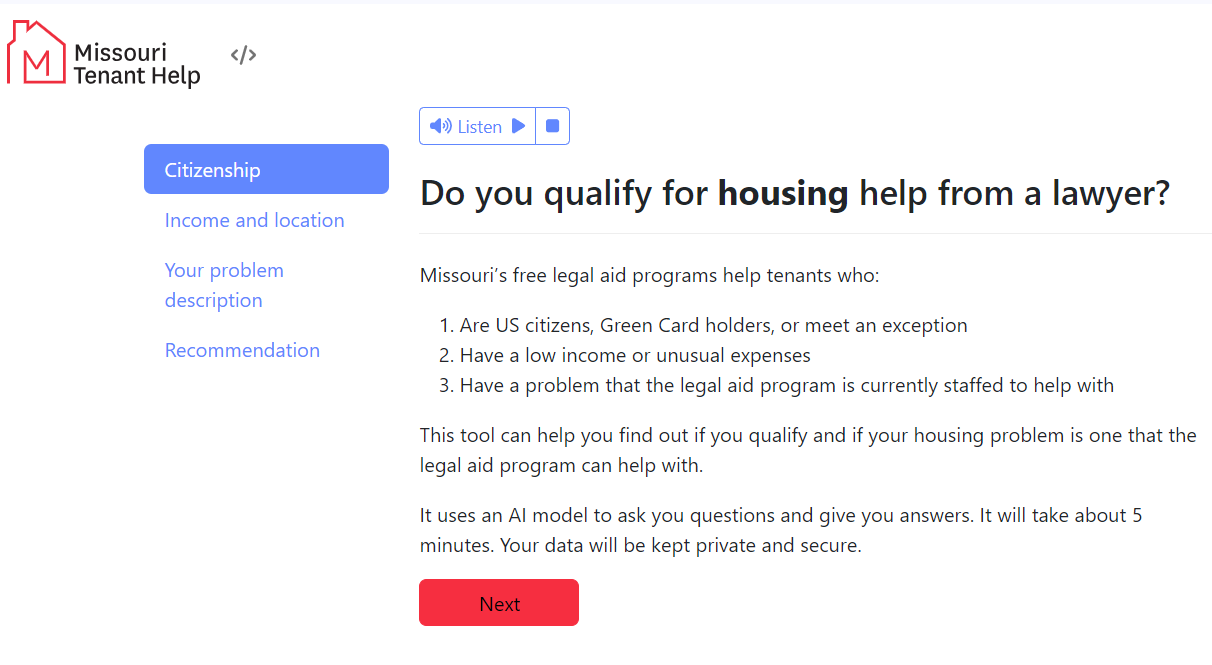
Missouri Tenant Help Intake Screener
A hybrid rule-based and LLM-powered intake screener developed for Missouri Tenant Help to help determine legal aid eligibility more efficiently and consistently.